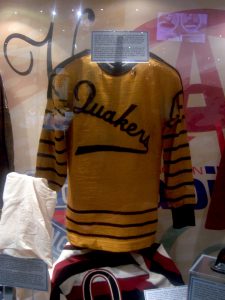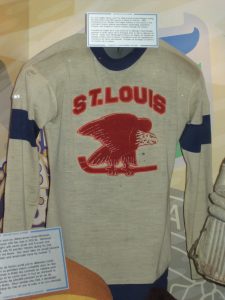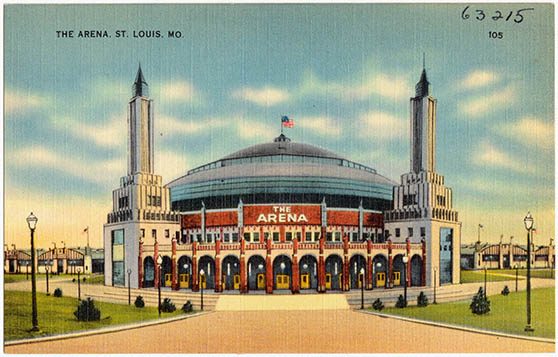This Day in Hockey History – November 8, 1934 – The Second One-Season Wonder
Two franchises had to relocate but folded after one season in the new location leaving those two cities without an NHL team until the 1967 expansion. The first game for each franchise in the new cities occurred just three days shy of four years apart. Philadelphia had its first NHL home game on November 11, 1930, and St. Louis had its first on November 8, 1934. After the Philadelphia Quakers and St. Louis Eagles folded, these would be the homes of the Philadelphia Flyers and the St. Louis Blues as of 1967.
Pennsylvania joined the NHL in 1925 as the Pittsburgh Pirates. Their mediocre play could not hold up against the memory of the Pittsburgh Yellow Jackets, who won the U.S. Amateur Hockey Association championship in 1924 and 1925. Fans rarely ever filled the mere 5,000 seats of Duquesne Garden, resulting in the lowest home attendance (40,000 in the season) in the NHL.

By Bachrach44, from Wikimedia
Commons
With the purchase of the team in 1928, the team’s record only worsened until the 1929-30 season ended 5-36-3. The team moved across the state to become the Philadelphia Quakers, still wearing orange and black. However, the rink at 45th and Market Streets only seated 6,000 and had poor sightlines. Still, the Quakers debuted there on November 11, 1930 and lost not only the game (3-0 to the New York Rangers) but their audience members. After many left that first game, only about 2,000 showed up for the next. The Quakers finally won in their third game but then lost 15 straight games, setting a NHL record not beaten until the 1974-75 Washington Capitals lost 17 in a row. At the end of the season, the Quakers only had a .136 winning percentage (4-36-4), the worst but for that same Capitals’ season. With the owners having lost over $100,000, they were permitted a suspension. Although meant for only one season, the team never actually returned, and the NHL formally closed the franchise in 1936. Philadelphia finally returned to the NHL 31 years later, in 1967.

By Nhl4hamilton|Chit-Chat, from
Wikimedia Commons
St. Louis’s team hailed from Canada’s capital. Although the Ottawa Senators had been a charter member of the NHL and had since won four Stanley Cup championships, they faced dwindling attendance and rising debts. They tried suspending operations for a season to raise money, but they finished in last for the two seasons following their return. The franchise looked for a bigger market elsewhere and decided on St. Louis, then the seventh-largest U.S. city with nearly 900,000 inhabitants. In St. Louis, the team kept most of its players but changed its name to the Eagles, after the Anheuser-Busch logo. St. Louis Arena, built in 1929 and converted to a hockey rink in 1931, had the unfortunate “distinction of being the only NHL stadium with racially segregated seating.” With a crowd of 12,622 at the first home game, on November 8, 1934, the Eagles lost 3-1 to the Chicago Blackhawks. Although they won their next game, they lost the next eight. The Eagles finished last with a record of 11-31-6.
For the Eagles, it wasn’t so much that St. Louis could not support a team, but that travelling to play in other cities cost too much. The franchise lost $70,000 that season primarily due to train travel to Canadian cities and northeastern U.S. cities. Apparently, the NHL was right in denying St. Louis a franchise back in 1932 based on prohibitive travel costs. At first, the Eagles tried selling players to dig themselves out of debt, and then they tried asking for a suspension like the one they had in Ottawa. Instead, the NHL put the team up for sale, then bought back the franchise, and finally held a dispersal draft to reallocate the players. The NHL would play with just eight teams. The same issue of travel costs prevented the Montreal Maroons from moving to St. Louis in 1938. Finally, the St. Louis Blues set up shop in 1967.
Additional Sources:
- https://quakers.flyershistory.net/
- http://mohistory.org/blog/scoring-an-nhl-first-in-st-louis/
- Brian McFarlane, Brian McFarlane’s History of Hockey (Champaign, Ill.: Sports Publishing Inc., c1997), 32-33, 37-38.















[…] Maroons in 1930-31. George coached the Ottawa Senators in 1933-34 and the next season, when they moved to St. Louis before folding. He continued coaching various teams and helped with choosing and training players for Canada’s […]